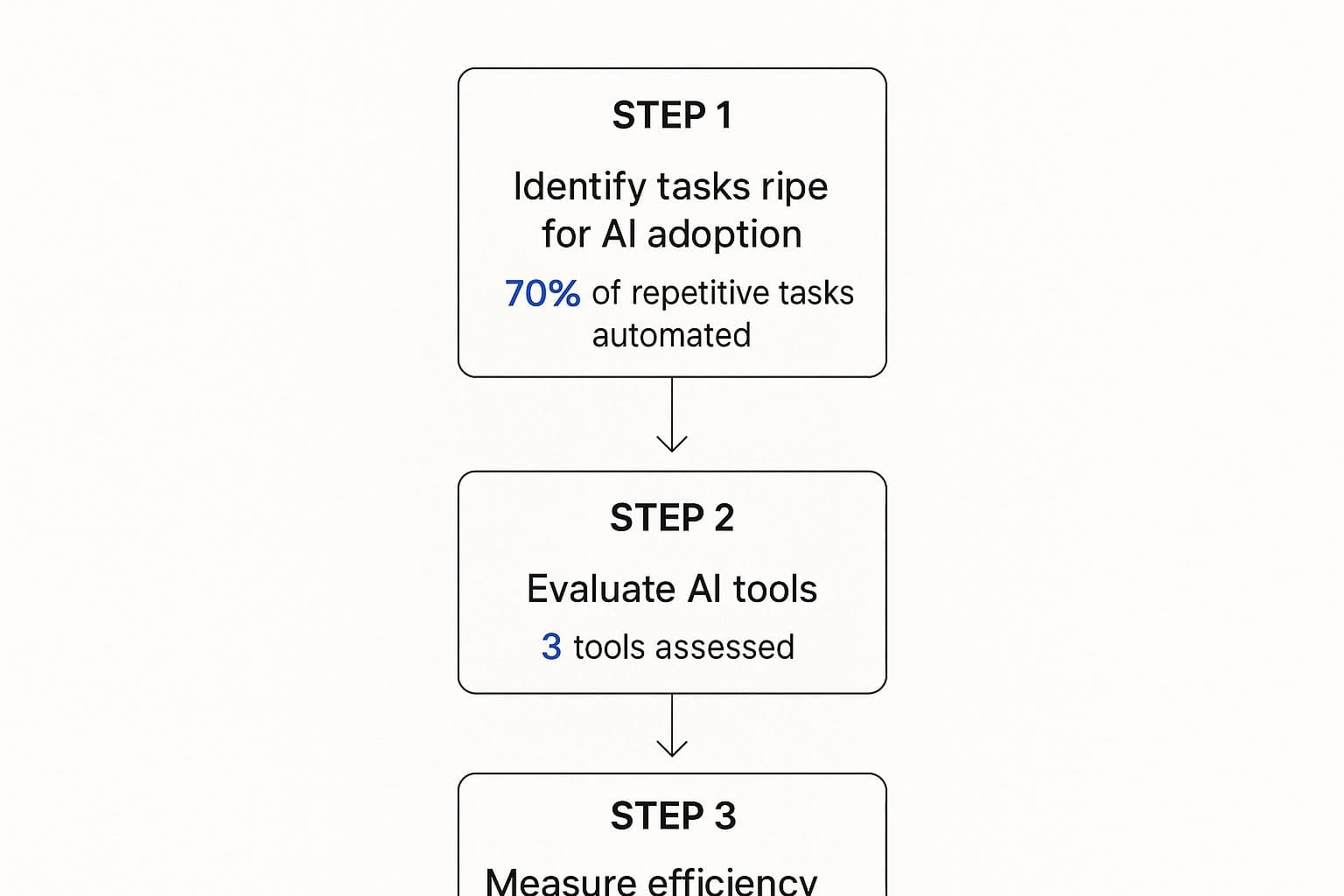Use AI More Efficiently: Boost Your Productivity with Text-Based AI
Learn how to use AI more efficiently with practical tips on crafting prompts and building workflows that enhance your productivity easily.

Ever feel like your AI tool is just a slightly smarter search engine? If you're getting bland, generic answers from text-based AI, you're not alone. The secret to getting incredible results isn't about finding a magic new tool—it's about changing how you talk to it. To gain meaningful benefits in your daily life, you need to be more productive with AI, and that starts with your approach.
You need to shift from barking simple commands to having a real conversation. It's all about giving clear context and detailed instructions. That’s when the AI goes from a clunky machine to a genuinely helpful partner for all your text-related tasks.
Stop Tinkering and Start Commanding Your AI

Lots of people use powerful text-based AI every day but are barely scratching the surface of what it can do. They get stuck in a frustrating loop of asking basic questions and getting mediocre answers back. The leap from just playing around with AI to actually being more productive with it isn't about the tech, but the technique.
AI adoption is exploding. Recent numbers show that around 35.49% of people are firing up AI tools daily, and a massive 84.58% have increased how much they use them in just the last year. As these tools become a normal part of our work life, just using them isn't going to cut it. We have to get good at it to see real benefits.
Why Your AI Prompts Are Failing You
The biggest mistake is treating AI like a vending machine. You put in a simple text request ("write an email") and expect a perfect, ready-to-use answer to pop out. This almost always leads to generic outputs that need a ton of editing. Sound familiar?
This frustrating cycle happens because we don't give the AI any guardrails. Without specifics on the goal, the tone, or the format of the text, the AI is left to guess. And it's usually not a very good guesser. That's where all the wasted time goes—rewriting your prompts, then rewriting the AI's disappointing answers.
The goal is to stop commanding and start collaborating. Think of your AI as a brilliant but inexperienced assistant who needs clear direction to do their best work with text.
Breaking out of this rut means learning to frame your requests with surgical precision. A well-crafted prompt is the single biggest lever you can pull to get a high-quality response and become truly productive with AI.
If you're ready to go deeper, our guide on how to write AI prompts is the perfect next step. It’ll show you how to turn your AI from a simple task-doer into a powerhouse collaborator, giving you a serious productivity boost.
How to Craft Prompts That Get Real Results
If you're getting lukewarm results from your text AI, the problem isn't the tool—it's the conversation you're having with it. Vague, one-line prompts lead to generic, uninspired answers. To really get the most out of an AI tool like TypeBoost, you have to stop making it guess what you want and start giving it crystal-clear directions.
Think of it like this: telling a friend to "write a summary" is a recipe for a useless document. But telling them to "summarize this meeting transcript into five bullet points, focusing on action items for the marketing team" gets them exactly where they need to be. This same logic is the key to unlocking AI's true potential for daily text tasks.
A Simple Framework for Better Prompts
I’ve found that one of the most effective ways to get consistently great results is by using a simple framework: Context, Role, Objective, and Format (CROF). It sounds a bit technical, but it's really just a checklist to make sure you're giving the AI everything it needs to handle your text-based request.
Sticking to these four elements will seriously upgrade the quality of every response, saving you tons of time on revisions.
- Context: Give the AI the backstory. What's the topic? Who is the email for? What's the critical information it needs to know to understand the situation?
- Role: Tell the AI who to be. Do you need it to be a professional copywriter? A helpful customer service agent? A technical expert? Giving it a persona changes the tone and style of the text.
- Objective: Be direct about what you want it to do with the text. Are you trying to summarize meeting notes, brainstorm email subject lines, draft a social media post, or rewrite a confusing paragraph?
- Format: Tell it exactly what the final output should look like. A bulleted list? A three-paragraph email? A table with two columns? A social media post with emojis and hashtags?
By providing these details, you’re turning a general AI into a specialist assistant dialed into your specific needs. This small shift is the secret to making AI a productive part of your daily life.
This quick visual shows how to pinpoint the best places in your day-to-day work where AI can have the biggest impact on your productivity.

As you can see, starting with those repetitive, text-heavy tasks is often the fastest way to get back hours in your week.
Transforming Vague Prompts into High-Value Outputs
Let's see how adding specific elements to a prompt turns a generic AI response into a highly useful, targeted result that saves you time. A little more effort upfront makes a massive difference in the quality of the output.
| Prompt Element | Inefficient Prompt Example | Efficient Prompt Example | Why It Works Better |
|---|---|---|---|
| Context | "Write about social media." | "Write about using Instagram Reels for a local coffee shop trying to attract younger customers." | Provides a specific topic, audience, and platform, focusing the AI's knowledge. |
| Role | "Create a marketing email." | "Act as an expert email marketer. Write a promotional email for a 25% off flash sale." | Assigning a persona (expert marketer) ensures the tone and tactics are appropriate. |
| Objective | "Brainstorm some ideas." | "Brainstorm 5 catchy blog post titles about remote work productivity hacks." | A clear, measurable goal (5 titles) directs the AI to a specific, actionable output. |
| Format | "Summarize this article." | "Summarize this article into 3 key bullet points, each no more than one sentence long." | Dictating the structure (3 bullet points) makes the output scannable and instantly usable. |
The difference is night and day. The inefficient prompts require heavy editing and follow-up questions, while the efficient ones deliver polished text that's nearly ready to go.
See the CROF Method in Action
Let’s walk through a real-world scenario. You just finished a client meeting and you're staring at a chaotic jumble of notes. Your goal is to send a professional follow-up email.
A vague prompt would be something like: "Summarize these meeting notes."
You'll get a bland paragraph back that's technically a summary but isn't very helpful. It's just more work for you to turn it into something you can actually send.
Now, let's try it again using the CROF framework.
Context: "These are my notes from a project kickoff meeting with our new client, 'Innovate Corp,' for their website redesign."
Role: "Act as a professional and friendly project manager."
Objective: "Draft a follow-up email that summarizes the key decisions we made, clearly outlines the immediate next steps for both our team and the client, and confirms the project timeline."
Format: "Structure the email with clear headings for 'Key Decisions' and 'Next Steps.' Use bullet points for all the action items. Make sure the tone is enthusiastic but professional."
This detailed prompt leaves nothing to chance. The AI knows exactly who to be, what information to include, and how to present it. It delivers a structured, actionable, and tone-perfect email on the first try, turning a messy task into a polished result in seconds. That’s how you make AI do the heavy lifting for you.
Build Personal AI Workflows That Save You Hours
Getting good at writing prompts is one thing, but the real breakthrough happens when you stop treating AI as a one-off tool and start building repeatable systems with it. To seriously use AI more efficiently, you have to weave it into the fabric of your daily grind. This means creating your own smart, personalized workflows that basically put your most common text-based tasks on autopilot.
Forget just asking for a single summary or a one-time email draft. Think bigger.
Imagine having a "Meeting Prep" workflow that scans your jumbled notes, extracts the action items, and drafts a follow-up email for you. Or what about a "Content Multiplier" workflow? You feed it one core idea from a document, and it helps you spin that into a LinkedIn post, a Twitter thread, and a newsletter snippet in just a couple of minutes.
The whole point is to pinpoint the repetitive, low-creativity parts of your job and build simple AI processes to take care of them. This frees up your brain for the work that actually requires your expertise—the strategic, creative stuff that only a human can do.
Find Your Automation Hotspots
First, become a detective in your own workday. Pay attention to all the small, recurring text-based tasks that drain your time and mental energy day after day.
Look for the patterns. Are you constantly rewriting the same kind of customer support email? Do you spend 15 minutes every morning summarizing articles for your team? Do you dread drafting weekly project updates? These are prime candidates for an AI-powered workflow.
A few common text-based "hotspots" are:
- Summarizing text: Turning meeting notes into action items, condensing long articles, or pulling key takeaways from reports.
- Repurposing content: Taking a single document and slicing it up into social media updates, or turning a client email into a case study.
- Standard communications: Drafting follow-up emails, whipping up project status updates, or answering the same frequently asked questions over and over.
Once you spot these, you can start to automate repetitive tasks with AI and claw back a huge chunk of your day. The secret is to start small. Pick one high-friction task and build out from there.
By chaining simple AI actions together, you create a powerful system that’s more than the sum of its parts. You’re not just saving time on one task; you’re streamlining an entire process.
Build a Simple "Content Multiplier" Workflow
Let's walk through a real-world example. Let's say you just wrote a quick paragraph announcing a new product feature. You need to get the word out on a few different channels, but you don't want to just copy and paste the same message everywhere.
Here’s how you’d do it:
- Start with the Core Idea: This is your original text, your single source of truth.
- Example: "Our new scheduling tool is now live! It helps users book appointments directly from their calendar, cutting down on back-and-forth emails."
- Fire Off the First Prompt: Use a tool like TypeBoost to apply your first command.
- Prompt: "Turn this into an engaging LinkedIn post. Add a question at the end to encourage comments."
- Run a Second Prompt: Now, go back to that same core idea and apply a different prompt.
- Prompt: "Rewrite this as a casual, two-sentence Twitter post. Add two relevant hashtags."
- And the Final Transformation: One last prompt to round things out.
- Prompt: "Expand this into a short, friendly paragraph for our customer newsletter. Emphasize the benefit of saving time."
In less than 60 seconds, you’ve got three unique pieces of content, all perfectly tailored for different platforms, and all stemming from that one original idea. This isn’t some futuristic concept; it’s quickly becoming standard practice.
Think about it: by 2025, a whopping 83% of companies globally will have AI high on their agenda. This includes 67% of small businesses already using AI for content marketing. Building smarter workflows isn't just a nice-to-have; it's essential for staying competitive. You can dive deeper into how businesses are adopting AI on blog.superhuman.com.
If you're serious about maximizing your efficiency, learning more about automating content creation for SEO success is a great next step. This shift from one-off commands to structured, repeatable systems is how you truly get hours back in your week.
Use AI as Your Creative Sounding Board
It's easy to fall into the trap of seeing AI as just a fancy automation machine. But if that's all you're doing, you're missing out on one of its biggest benefits: making you smarter and more creative. To really get the most out of these tools, stop treating them like a vending machine for text and start treating them like a tireless brainstorming partner.
This one mental shift changes everything. Instead of just asking for a finished product, you start a conversation. You use the AI to poke holes in your own ideas, challenge your assumptions, and find entirely new ways of looking at a problem. It becomes less of a tool and more of a creative sidekick for your daily thinking.
Go Beyond Basic Idea Generation
Most people's "brainstorming" with AI stops at "give me 10 ideas for X." That’s a start, but the real magic happens when you push it to be your biggest critic. You can use it to pressure-test your concepts and find the weak spots before anyone else does.
This is all about moving from simple requests to a real back-and-forth dialogue.
- Ask for a tough critique: Don't ask if your idea is good. Ask the AI to tell you why it's bad. A prompt I love is: "Act like a skeptical editor and critique this paragraph. What are its three biggest weaknesses?"
- Play devil's advocate: Get the AI to argue against you. Try this: "My argument is [your argument]. Act as a devil's advocate and give me three rock-solid counterarguments."
This kind of interaction forces you to build a stronger case for your ideas. It's like having an on-demand sparring partner who can instantly sharpen your thinking.
I’ve found that using AI to find the holes in my own logic is the single fastest way to make my work better. It helps you get ahead of objections and fine-tune your strategy before you’ve invested too much time or energy.
Get a Fresh Perspective on Old Problems
Ever feel like you're stuck in a rut, looking at a problem the same way over and over? The issue isn't always the problem itself—it's your perspective. AI is incredible at reframing a situation from dozens of different angles, which is often exactly what you need to break through a creative block.
Let's say you're wrestling with a tricky customer service email. Your brain is probably stuck on company policies. To find a truly great solution, you need to see it through the customer's eyes.
You could ask the AI: "Rewrite this customer complaint from their point of view. Focus on their feelings of frustration and what they might be thinking."
That simple prompt can spark a wave of empathy and unlock solutions you would have never seen. This works for just about any text-based problem, from writing better marketing copy to figuring out how to communicate better with your team.
Find the Perfect Analogy to Explain Anything
Are you struggling to explain a complex topic in an email or presentation? AI is an analogy-generating machine. It can take a really dense, abstract idea and connect it to something simple and familiar, making your message stick.
The next time you’re trying to simplify something complicated, give this a shot: "Explain [your complex topic] using a simple analogy related to cooking."
By giving it a familiar sandbox to play in—like cooking—you guide the AI to come up with something that’s not only creative but also genuinely easy to understand. This doesn't just help your audience; it often helps you understand the subject on a deeper level, too. It’s a shortcut to clearer thinking and more powerful communication in your daily life.
How to Choose the Right AI Tool for the Task

The world of AI tools is a noisy, crowded place. It's easy to get overwhelmed, and picking the wrong one for the job is a massive time-waster—not to mention a surefire path to frustration.
If you really want to use AI more efficiently, you need a simple, deliberate way to build your personal toolkit. Instead of chasing every new shiny object, the real trick is matching the tool to your actual, day-to-day text-based tasks. It's not about having dozens of subscriptions; it's about having the right one for the moment, so you can stop constantly switching between apps.
Generalists vs. Specialists vs. Integrations
Most of the text-based AI tools you'll run into fall into one of three buckets. Once you get the hang of their strengths and weaknesses, you can start building a setup that actually works for you without breaking the bank.
- General-Purpose Chats (The Powerhouses): These are the big names you know, like ChatGPT or Claude. They're incredibly flexible and can handle almost any text task you throw at them—deep research, brainstorming, long-form writing. Think of them as a Swiss Army knife. They can do a lot, but they might not be the quickest for a specific job like fixing grammar.
- Specialized Writing Assistants (The Experts): This group includes tools like Grammarly or other apps built for one purpose, like improving clarity or fixing grammar. They are designed to do one thing exceptionally well, giving you a much more focused and polished result for that single task.
- Integrated Tools (The Sidekicks): You're probably already using these without even thinking about it. They're the AI features built right into your favorite apps, like Notion AI or Microsoft Copilot. Their biggest selling point is convenience. They live right inside your workflow, making them perfect for quick text edits without ever opening a new tab.
The goal isn't to pick one category and ignore the others. The most productive people I know use a mix, grabbing the right tool for whatever text they're trying to improve.
A classic mistake is trying to force a generalist tool to do a specialist's job. I see it all the time—people wrestling with ChatGPT for ten minutes just to do a simple grammar check. Picking the right tool from the start saves way more time than trying to craft the perfect prompt for the wrong one.
Building Your Personal AI Stack
So, how do you actually choose? It all starts with looking at what you actually do with text all day. A freelance writer's ideal toolkit is going to look completely different from a project manager's.
If you're doing heavy-duty creative writing, a powerful general-purpose chat is probably your best friend. But for those quick fixes—like making an email more concise or checking a report for errors—an integrated tool or a specialized AI writing assistant is almost always faster. We go a lot deeper into how these assistants fit into a modern workflow in our guide on what an AI writing assistant is and how to use it.
The good news is that these tools are becoming more accessible. The tech is getting better and cheaper at a wild pace. For instance, between November 2022 and October 2024, the cost to run models like GPT-3.5 plummeted by a mind-boggling 280-fold. As you can see in the full AI Index Report 2025, this trend means these powerful tools are opening up to more people around the world.
At the end of the day, the right tool is the one that feels like it disappears into your routine, taking friction away instead of adding another annoying step.
Got Questions About Using AI? We've Got Answers.
As you start making AI a real part of your day-to-day work with text, you're bound to hit a few snags. It's totally normal. Think of this as your quick-start FAQ for sidestepping the most common roadblocks people run into when they're trying to get a real productivity boost from their AI tools.
How Much Context Should My AI Prompt Have?
This is a big one. The best way to think about it is like briefing a new junior team member on a writing task. You wouldn't give them a ten-year company history, but you also wouldn't just say "write a blog post" and walk away. You need to find that perfect middle ground.
A solid prompt for a text-based task almost always includes:
- The end goal: What's the point of this text? What are you trying to accomplish with this email or document?
- The audience: Who are you writing for? A potential customer needs a very different tone than your boss or a team of engineers.
- Must-haves: Are there any specific names, details, or keywords that absolutely have to be in the final text?
If you find yourself writing a mini-novel for a prompt, you've probably gone too far. Start with the essentials. You can always add more detail if the first draft isn't quite right.
Can I Actually Trust the Information AI Gives Me?
Short answer: No. At least, not blindly.
My advice is to treat your AI like a super-enthusiastic intern who's brilliant but also makes stuff up sometimes. It’s amazing for brainstorming, whipping up a first draft of an email, or summarizing a document. But it can also state a complete fabrication with the confidence of a tenured professor.
Always, always, always double-check any facts, numbers, or critical info yourself. The best workflow is to let AI handle the initial heavy lifting of writing, then use your own brain and trusted sources for the final fact-check.
This isn't a bug; it's just how the technology works right now. Building that verification step into your routine is non-negotiable. It’s what separates the pros from the amateurs and saves you from some seriously embarrassing mistakes.
Is It Better to Use One AI Tool for Everything, or Several?
For most people, sticking to just one tool for all your text needs is a trap. You'll end up trying to hammer a screw. A much smarter approach is to have a small, curated toolkit where each tool does its job exceptionally well.
Here’s a setup that works great for me and many others for daily text tasks:
- A main "heavy-lifter" like ChatGPT or Claude for the big stuff—deep research, brainstorming sessions, and drafting long articles.
- A specialized, integrated tool that works right where you type. This could be an AI assistant in your email for quick replies or a system-wide tool for fast edits anywhere.
This hybrid model gives you the best of both worlds: raw power when you need it and effortless convenience the rest of the time. You get the right tool for the job without getting bogged down by a dozen different apps.
Ready to stop switching tabs and start applying your best AI prompts everywhere you work? TypeBoost integrates directly into your macOS workflow, letting you enhance text in any app with a single keyboard shortcut. Start your free trial of TypeBoost today.